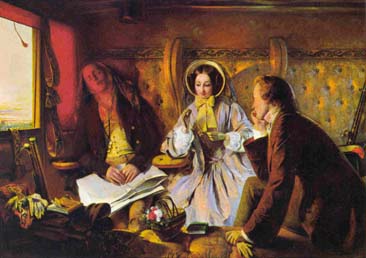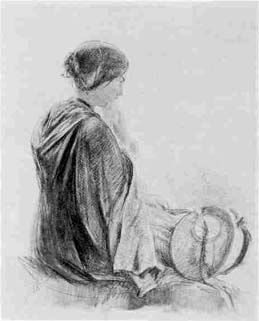
Bulletin 9-10 (V:1-2), 1967
Home
Français
Introduction
History
Annual Index
Author &
Subject
Credits
Contact



Two
Paintings by Abraham Solomon
by Ian Lowe, Assistant Keeper, Department of Western Art, Ashmolean
Museum, Oxford, England
Résumé en français
Pages 1 | 2
At the eighty-sixth
exhibition of the Royal Academy in 1854, Abraham Solomon (1824-1862)
exhibited a pair of paintings which caught the attention of the
public; these were First Class - the meeting..."And
at first meeting loved" and Second Class -the parting /
"Thus part we rich in sorrow Parting poor." (1)
First Class (plate 1) is now in the National Gallery of Canada
in Ottawa (2) while its pair (plate 2) has remained at Bowood in the
collection of the Marquess of Lansdowne, (3) having been purchased by
the third Marquess from the Royal Academy for two hundred and fifty
guineas. (4)
The comments of the critic of the Art Journal still have
relevance and interest: "The subject (of First Class) is
an adventure in a railway - carriage; there are three figures: one,
an elderly gentleman in the right [sic] hand corner, is
asleep, while between the other two, a youth and a maiden, there
seems to have arisen a tendresse. As a picture, it is
executed with great knowledge and power, but it is, we think, to be
regretted that 50 much facility should be lavished on 50 bald - or
vulgar - a subject"; and regarding Second Class: "This
is a pendant to a picture by the same artist already noticed, called
'The Meeting'; but it is superior to the latter in everything. A
widow is accompanying her child, a sailor boy, to Portsmouth or
Southampton, whither he is proceeding by railway to join his ship,
bound on a long voyage, The characters are well drawn, and the story
is pointedly told". (5)
The critic of Punch, Rhadamanthus, joined issue on the
subject of the two paintings with the critic of the Spectator, Minos:
"I find that we do differ on one picture - Mr Solomon's Second
Class. Minos calls it sentimental, using the word by way of
disparagement. I confess that neither from the picture nor the word
can I gather what Minos objects to. It seems to me for my part, that
the subject is a well-chosen one...The subject is one that concerns
motherly, sisterly and filial love; and the workings of these
various affections are shown without weakness or overforcing. I find
the public understand the picture and are touched by it; and I must
own that to my mind it excels everything the painter of it has
hitherto produced. Its companion picture, the First Class, pleases
me less. I admit that the old gentleman sleeping in the sunlight is
capital, but the young lady looks to me affected, and the 'gently fearlessly assert and will maintain to be an arrant spooney. (6) But
set ting aside this difference in our verdicts - Minos and myself
are of one mind - as to the pictures chosen for chief
praise". (7)
Despite the praise mentioned in the last sentence, the artist, with
a humility which now seems surprising, appears to have taken the
hostile criticisms to heart, for he painted another version of First
Class. In this he endeavoured to eliminate all traces of the
"bald" and the "vulgar" from the subject.
Until the original version of First Class appeared at an
auction in London in 1963, (8) it had been thought that it might have
been destroyed by the artist as a result of the hostile notice it
had received. (9) Certainly the artistic importance of the first
version had been over-looked. Yet even had it not reappeared, ample
evidence of the first composition would have survived in a small,
charming oil study for the finished painting (plate 3). The only
detail that is not in the oil sketch is the fishing rod on the
right-hand seat. In both the sketch and the painting the artist's
handling of the light shed by the set ting sun through the blind,
the glimpse of the sunset through the window and the interior of the
old London North Western Railway carriage (10) is lively and delicate.
An oil sketch was also made for Second Class (plate 4). (11)
The colours in both oil sketch and painting are quiet and predominantly grey in tone; whereas those in the oil sketch and the
original painting of First Class are vivid. This contrast in
colour illustrates and emphasizes the different nature of the two
subjects. The revised First Class shares the tonality of Second
Class.
Abraham Solomon's second version of First Class - the meeting, previously
known only from replicas, is here identified as being the painting
which is now in the Museum of British Transport at Clapham in
London. (12) A pair, thought to be replicas, had been known to be in
a private collection in Yorkshire since 1951, and in 1959 the two
paintings were acquired for the British Railways Board's museum. Sir
David Scott had suggested to the writer that the artist had probably
painted a revised version of First Class as a pendant to Second
Class, although its whereabouts were no longer known. The exact
similarities of the size of the canvases and the painted arched tops
(overpainted in recent years in the case of the second version)
together with the artist's autograph signature and the date 1855
establish convincingly that this painting is that postulated
pendant. As Lord Lansdowne had purchased Second Class at the
Royal Academy the previous year, Solomon had to paint another
version of it, also the same size, in order that his revised First
Class could hang with its pendant, This "second" Second
Class is at Clapham and although it is neither signed nor dated,
there is no reason to doubt its authenticity.
A further comparison between the two versions of First Class shows
that the most obvious change made in the second, and decidedly
inferior, version is in the treatment of the figures. The young lady
has been moved from the centre of the composition and here, instead
of being genuinely preoccupied with her work, she is looking coyly
at the young man. The old gentleman, who was comfortably and perhaps
even stertorously asleep in the corner, is now in the centre engaged
in conversation with the young lieutenant. (13) This third
protagonist has been transformed from a civilian "spooney"
into a naval officer, and the hint of a pleasurable excursion,
suggested in the former's fishing rod, is now replaced by a reminder
of duty in the shape of the latter's sword, The differences
between the two versions are marked and the superiority of the
original painting and the corresponding oil sketch is decisive, in
the original, the group is instinct with an emotion that is wholehearted, even vibrant,
but not sentimental, Indeed the Art Journal's
criticism could more accurately be applied to Solomon's second
than to his first version of First Class.
Of the three pairs of replicas in existence, one pair (14) is
distinguished by the artist's characteristic freshness of colours
and dexterity. The figures are painted on a prepared white ground, a
practice which Holman Hunt had introduced to fellow members of the
Pre-Raphaelite Brotherhood. (15) This accounts for the quality of
translucency in this pair, The replica of First Class is a
compromise between the original and the second version; the expression of the lady is closer to the original but the composition
is still deficient in that strength of feeling which is so notable
in the painting in the National Gallery of Canada. The two other
pairs of replicas are probably not from Abraham Solomon's hand. (16)
It is interesting to consider a drawing recently purchased by
the Ashmolean Museum. (17) It is a study of the sister who appears
in Second Class (plate 7), seated with her hat beside her.
Skillfully drawn in black chalk, it is signed and dated 1853, the
year before the two paintings were exhibited at the Royal Academy.
When it was taken out of its former frame and mount, a study for the
original version of First Class, was found on the verso
(plate 6). Here the young man is looking eagerly across the railway
carriage at the demure young lady, the old gentleman being just
visible in the corner. The drawing therefore gives further
supporting evidence, had it been needed, of the artist's first
composition.
Next Page | Notes
1 | 2
Annual Index | Author & Subject | Credits | Contact
This digital collection
was produced under contract to Canada's Digital Collections program,
Industry Canada.
"Digital
Collections Program, Copyright
© National Gallery of
Canada 2001"